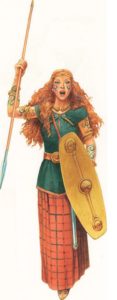Below is a detailed article that talks about the opposition to the Roman rule led by tribal leaders in the British Iron Age. They were Celtic and had a perfectly established system of public administration. They had to face the Roman invasion in 43 AD, which they resisted with all their might.
The Catuvellauni were an aggressive tribe capable of defending their expanding territories against the Romans. Under Caratacus and Togodumnus the fight began in 43AD, leading the resistance in the south east of England against the Roman invaders led by Aulus Plautius.
Which tribal leader fought against the Roman conquest of Britain?
Boudicca from the Iceni tribe was the tribal leader that is known for her resistance against the Roman conquest of Britain. Boudicca was Celtic Welsh and is considered a British folk hero. She was married to Prasutagus. Together, they had two children. He had a treaty with the Romans that the kingdom along with Boudicca and their children would be protected.

However, after his death, the Romans annexed all their property and according to many references, raped their daughters. This was around 60 AD when Gaius Paulinus was the Roman Governor. Iceni tribe was located in the northwest coast of Wales from where Boudicca led her conquest against the unjust Romans. They started out with destroying Colchester which was the capital of the Romans in Britain. They outnumbered the Roman soldiers.
Boudicca raised a very large army and also destroyed the temple of Claudius. They defeated one of the legions and also burnt the Roman towns – Londinium and Verulamium. In this revolt, both Roman and British settlements were affected. Nearly 70000 to 80000 British as well as Romans were destroyed.
They posed a large threat to the Romans and even caused Emperor Nero to consider withdrawing all Roman forces from Britain back to Rome. However, Suetonius – a Roman commander gathered all the forces and worked on a strategic battalion and defeated the Britons. Boudicca realized that she and her very little left forces would now have to give up. This is why she committed suicide and thought it best to take own her life rather than being captured by the Romans.
Due to the revolution of literature in the Victorian era, Boudicca’s epic was made famous and she now stands as a cultural symbol of the United Kingdom. There is a 6th-century piece of work written by a monk called Gildas – On the Ruin and Conquest of Britain. He has called Boudicca a treacherous yet brave woman that butchered the Roman governors.
It is believed that the land on which King’s Cross in London stands is actually the site of a great battle between the leader of the Iceni tribe – Boudicca and the Roman governors. Earlier, King’s Cross was a village called ‘Battle Bridge’ which supports this theory. In 1937, author Lewis Spence published a book ‘Boadicea – warrior Queen of the Britons. The book has interesting details of the battle and about Boudicca’s passion to protect her tribe.
